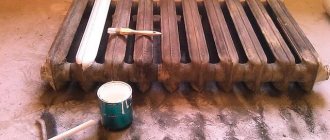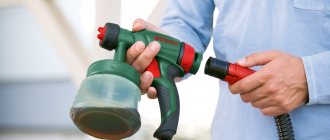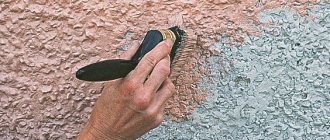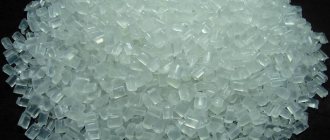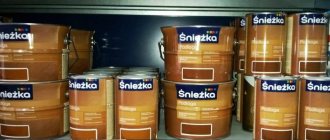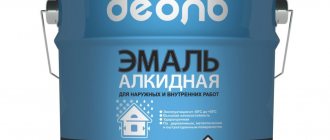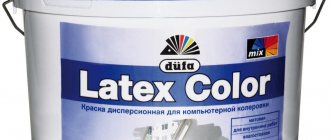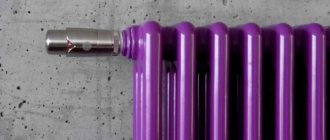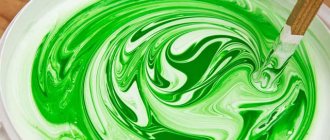How not to dilute enamel for heating radiators
The appearance of cast iron heating radiators requires periodic updating. This is necessary not only for aesthetics, but also to extend service life. Aluminum and steel radiators have a special powder coating and, as a rule, do not need to be repainted. Today there are many varieties of paints on sale designed specifically for radiators. Enamels are best suited for cast iron batteries. Which ones exactly, how to apply them correctly, what can and cannot be used to dilute enamel paints - we will talk about this below.
Types of enamels for cast iron batteries
Despite the modern abundance of heating radiators, cast iron batteries continue to be in demand. There are quite a lot of reasons for this, and it makes no sense to list them. Cast iron radiators require periodic surface painting. In this case, the paint must meet the following requirements:
- Maintain a temperature of about 80 C.
- Be environmentally friendly.
- It is good to protect the surface and give it an attractive appearance.
- Maintain the original appearance for a long time.
During the Soviet shortage, the choice was, to put it mildly, small: oil paint or silver paint. Today, several types of enamels are used to paint radiators:
Alkyd - creates a durable coating on the surface that can maintain the integrity of the structure for a long time. Among the shortcomings, one can note, first of all, a pungent odor that does not disappear for a long time. You can dilute alkyd enamel to the desired consistency:
- White spirit;
- Solvent;
- Xylene;
- Turpentine;
- 646 solvent.
It is highly not recommended to dilute paint with gasoline and diesel fuel.
Water-dispersed alkyd enamel
It dries very quickly, does not have a repulsive odor, and is strong and durable. It is diluted, as the name implies, with ordinary clean water. Other solvents are not recommended.
Acrylic enamel
Advantages - the surface does not need to be primed, the paint is very easy to apply, it dries quickly and does not smell. Acrylic paints are diluted with water, alcohol diluted with water, as well as special acrylic thinners. Universal solvents are not suitable for acrylic paints.
In order not to make a mistake when choosing a solvent for enamel, you need to clearly know its composition. The universal solvent is considered to be 646 nitro solvent. However, some enamels cannot be diluted with products that contain acetone, as they curl. Manufacturers always indicate recommended enamel thinners on the label, which cannot be replaced with analogues.
Popular products
There are a large number of paint solvents, as one might understand. The main thing is not to get confused when studying symbols and markings.
P-4 is a popular variety that contains toluene and acetone. It is used when dissolving alkyd paints and enamels for metal, compositions with chlorinated polymer. All ingredients form a successful combination, thanks to which the paint easily acquires the desired consistency per 1 kg.
Upon completion of painting, a film appears on the surface, serving as additional protection. This composition is mainly used for degreasing surfaces.
Solvent R-4 has the following properties:
- high volatility;
- flammability;
- the need to observe safety measures when working.
Composition 646 has become even more popular; it is easy to use both in industry and in domestic conditions. Can be a degreaser and solvent. The main advantage is its wide scope of application. Multifunctionality and technical characteristics are among the main advantages.
Using solvents in everyday life (2 videos)
Solvents of different groups (24 photos)
How to dilute acrylic paint?
Acrylic paint is a safe, non-toxic paint and varnish material made on the basis of pigment, a binding component, and water. After evaporation and complete drying of the water base, a frost-resistant, elastic, cracking and delamination-resistant protective coating is created. This type of paint is used for painting wooden, metal, and plastered surfaces.
It has special advantages compared to other paints and varnishes:
– environmental friendliness – complete safety for health and the environment due to the absence of toxic substances;
– the widest color palette;
– comfort of use, achieved by quick drying of the painted surface, ease of use, including washing;
– absence of unpleasant odor, which allows you to dispense with a respirator mask when working;
– long service life – at least ten years;
– the acrylic layer does not allow water to pass through.
There are several types of acrylic paint depending on the following indicators:
– application option (external and internal work);
– resistance to environmental factors (moisture resistance, light resistance, resistance to mechanical factors);
– gloss and degree of whiteness;
According to its structure, acrylic paint is a thick material that requires dilution before work to ensure convenient application and uniform distribution. The need for dilution arises after the material has been open for a long time.
There are several options for thinners.
LKMFLOT
Code: 100907873
Category:
Paints and Enamels
Brand:
Caparol
Packaging:
12.5
Packaging:
1
DESCRIPTION:
Paint Caparol Malerit-Double V.
Paint for interior use, solvent-free, with fungicidal properties, wash-resistant.
Area of application: For high-quality, wash-resistant, sanitizing paints together with Capatox or FungiGrund on mold-affected and mold-prone interior surfaces, to maintain indoor hygiene in private housing.
Properties: solvent-free, water-soluble, low odor, diffusible, sd has fungicidal properties, contains silver ions for biocidal prevention. Resistant to washing, class 3 wet abrasion.
Binder: Artificial resin dispersion according to DIN 55945 standard.
Packaging: 12.5 l.
Color: White.
Can be tinted with full-tone and tinting paints with the addition of max. 5% AVA – Amphibolin, or full-tone and tinting paints CaparolColor (formerly Alpinacolor). When tinting paint individually, all the required amount of material must be mixed together to avoid differences in color shades. When purchasing paint of one shade from 100 liters of paint or more, factory-tinted material can be supplied to order.
Juicy, intense shades of paint, under certain circumstances, have limited hiding power. Therefore, with such shades, it is recommended to first apply a topcoat on a white base, tinted in the pastel shade closest to the finish. A second topcoat may be required.
Gloss level: Deep matte (according to DIN EN 13 300 standard).
Storage: In a cool place, not in the cold.
Technical parameters: Technical data according to DIN EN 13 300: When tinting, deviations from the technical data are possible. Wet abrasion (abrasion) Class 3, corresponds to resistance to washing, according to the DIN 53778 standard. Degree of contrast (hiding ability) 2nd hiding power class with an output of 7 mI/l or a flow rate of 140 ml/mI.
Maximum grain size Fine (no more than 100 microns).
Density Approx. 1.5 g/cm3.
Suitable substrates: Substrates must be free of contamination, separating substances and dry.
Preparation of the substrate: Plasters of mortar groups P II and P III: Durable plasters with normal absorbency should be coated without pre-treatment. Large porous, lightly sandy, absorbent plasters should be primed with OptiGrund ELF or CapaSol LF.
Gypsum plasters and lathing for plaster mortar group P IV: The primer coating is carried out with Caparol-Haftgrund primer. Sand gypsum plasters with sinter and remove dust, apply Caparol-Tiefgrund TB primer.
Plasterboard panels: Prime absorbent panels with OptiGrund ELF or Caparol-Tiefgrund TB. Apply Caparol-Haftgrund adhesive primer to heavily compacted smooth panels.
Gypsum boards (plasterboard panels): Sand off putty beads and burrs. Seal soft and sanded areas with applied gypsum putty with Caparol-Tiefgrund TB primer. Prime with Caparol-Haftgrund or CapaSol LF. Prime sheets with pigment spots from water-soluble ingredients with Caparol AquaSperrgrund. Observe the instructions in BFS leaflet no. 12.
Concrete: Remove possible separating substances such as chalking and crumbling substances.
Porous concrete: Apply a primer layer with Capaplex, diluting it with water in a ratio of 1: 3.
Facing sand-lime brick: Paint without pre-treatment.
Load-bearing coatings: Treat matte, low-absorbent coatings directly. Roughen glossy and varnish coatings. The primer is coated with Caparol-Haftgrund.
Coatings without load-bearing capacity: Remove loose lacquer coatings and dispersion paint coatings or plaster coatings based on artificial resins. On slightly absorbent, smooth surfaces, prime with Caparol-Haftgrund. Apply OptiGrund ELF or CapaSol LF primer to large-porous, lightly sanded or absorbent surfaces. Coatings based on mineral paints without load-bearing capacity should be removed mechanically and the surface should be cleaned with a vacuum cleaner. Prime with Caparol-Tiefgrund TB.
Coatings with adhesive paints: Thoroughly wash off the old paint. Prime with Caparol-Tiefgrund TB.
Unpainted brushed, embossed or embossed paper wallpaper: Paint without pre-treatment.
Wallpaper that is not firmly in place: Remove completely. Wash off the glue and remaining paper. Prime with Caparol-Tiefgrund TB.
Surfaces contaminated with nicotine, water, soot or grease stains: Wash off nicotine stains, as well as soot and grease stains with water with the addition of fat-dissolving detergents and allow to dry thoroughly. Dry dried water stains by brushing. The insulating primer coating is carried out with Caparol AquaSperrgrund primer.
Wood and wood-based materials: Coatings are applied with water-borne, environmentally friendly varnishes Capacryl Acryl-Lacken or Capacryl PU-Lacken.
Small defects: After preliminary preparation, fill with Caparol-Akkordspachtel in accordance with the application instructions and prime if necessary.
Application method: Designed for application by brush or roller. Wash working tools with water immediately after use.
Coating structure: Preliminary preparation: Wash off possible mold deposits with water. Wash surfaces with Capatox or FungiGrund and allow to dry thoroughly. At the same time, comply with legislative and departmental regulations (for example, the procedure for using biologically active and hazardous substances).
Primer or intermediate coat: Malerit-W diluted to max. 10% water.
Finish coat: Malerit-W, diluted to max. 5% water.
Flow: Minimum flow approx. 140 ml/m2 per 1 pass on a smooth substrate. On rough substrates the consumption will be correspondingly higher. The exact consumption is determined by test application. The thickness of the painted layer significantly affects the duration of action of fungicidal and bactericidal agents. Therefore, Malerit-W should always be applied in a thick and even layer. You cannot use a product with less consumption than indicated.
Application conditions: Lower temperature limit for processing and drying: Air and substrate temperature must be +5 °C.
Drying/drying time: At +20 °C and 65% relative air humidity, after 4–6 hours the surface is dry and ready for further processing. Complete drying and ability to bear loads is achieved in approximately 3 days. At lower temperatures and high air humidity, the drying time increases accordingly.
Note: In areas where food is stored, it is not permitted to use paints and varnishes containing solvents. Therefore, in these rooms, only OptiGrund ELF should be used for priming. These rooms, after coating with Malerit-W, must be ventilated for at least 3 days before further use. Malerit-W darkens in reaction to heavy metal salts dissolved in water, such as copper salts. In this case, special consultation should be sought. Indeko-W or Fungitex-W should be used on interior surfaces damaged by mold or susceptible to mold, especially in areas used for industrial purposes.
When using Caparol-Tiefgrund TB indoors, the coating may emit a typical solvent odor. In this regard, care should be taken to ensure good ventilation. For sensitive areas, use the aromatic-free and low-odor AmphiSilan-Putzfestiger.
Covering power: Paintings made with Malerit-W can be treated with dispersion paints or paints based on polymerization resins, as well as plasters. Oil-based paints and paints based on oil-alkyd resins are not suitable as the substance contained in Malerit-W hinders the drying process.
Diluting acrylic paints with water
The basis of acrylic paints and varnishes is water, so it is advisable to use it to achieve the required consistency. An important point: you need to use only clean and cold water, standing for several hours or distilled, to prevent interaction between the components of the paint and varnish material and the thinner.
– dilution with water 1:1 – the material can be used to create a base layer, the paintwork lays down evenly, without smudges or sagging, forming a uniform coating that effectively protects the surface from corrosion and aggressive environmental influences;
– 1:2 – the consistency is more liquid, allowing you to create a thin and even layer, the paintwork material saturates the brush or roller well;
– 1:5 – creates “colored water”, which is used to color textured details; the composition is well absorbed and fills depressions and other depressions on the surface;
– 1:15 – the proportion is not used often, it is intended to create a transition between tones (gradient); in fact, it is no longer paint, but colored water.
After applying acrylic water-based paint and varnish material, you must immediately thoroughly clean the tool used. This is explained by the fact that after drying, water-based acrylic paintwork becomes water-resistant. And, accordingly, rollers, brushes and other painting tools, once dry, cannot be cleaned.
Which solvents are suitable for which paints?
Let's now take a closer look at the types of solvents and their applications.
Solvent for alkyd paints
The composition of alkyd paint includes alkyd resin and drier additives, which are responsible for the speed of drying of the paint.
Alkyd paints are good because they perfectly protect the surface from corrosion inside and out. Most often, alkyd paint is used for painting ceilings, walls, furniture, radiators, window frames, and doors. But you need to take into account that it is not very environmentally friendly and retains an unpleasant specific odor for a long time after drying.
Regarding which solvent to use for alkyd paints, we note that it is best to do this with turpentine, drying oil, or white spirit. The latter is the most popular. It is purified kerosene. Many people use regular kerosene to dilute alkyd paint. But do not forget that it is very toxic and much more expensive than white spirit. For this reason, we do not recommend that you use it.
Solvent for oil paints
Oil paints are diluted with organic solvents, which can evaporate quickly.
These liquids require careful handling as they can penetrate microcracks in the soil. You should also not forget that strong dilution of oil paint with a solvent can lead to destruction of the paint layer - the paint will become fragile and friable.
At the same time, the solvent for oil paints has good permeability, it promotes the penetration of oils between layers of paint, making the paint look much more beautiful and become stronger.
Also note that some thinners make the paint lighter, but after drying the paint returns to its original color.
What kind of solvent can be used for oil paints? Let's take a closer look.
1) You can use a mixture of white spirit and gum turpentine in a 1:1 ratio. But such a thinner for oil paints can be used to prepare paints for sketches.
2) White spirit itself is used as another solvent for oil paints. It was discussed in more detail above. It is widely used for cleaning paint from palettes and brushes after work. But in construction work it is not used as a solvent for oil paints, since it has low dissolving ability and high permeability.
3) The most effective solvent for this type of paint is pinene. It is a product of rectification of gum turpentine, as a result of which the resinous parts of the turpentine are separated. Another advantage of pinene is that it is much less susceptible to oxidation than turpentine. It is worth considering that it is not recommended to use turpentine in painting, as it is prone to yellowing. When diluting paints with pinene, you need to take into account that the gloss will also decrease.
All thinners should be stored in tightly closed containers.
Finally, we would like to add that today they have begun to produce special turpentine for artistic paints, and many also use any oil of vegetable origin.
Dilution with special acrylic thinners
Dilution with water or water with alcohol is only permissible when using a roller or brush. Paint sprayers and spray guns (painting equipment) require the use of acrylic thinners, the brand of which must be indicated by the manufacturer on the packaging. They have a specific smell and transparent appearance. The required amount of addition of such liquid depends on the scope of application, temperature and humidity of the external environment. Depending on the composition, acrylic solvents create a matte or glossy layer on the surface. Different coloring effects are achieved using a certain proportion, which is usually indicated on the thinner packaging.
Advantages of using acrylic solvent:
– accelerated drying time;
– the ability to create a matte or glossy surface;
– formation of an even layer without streaks and white deposits;
– chemical purity, compared to water;
– increased stability of paint characteristics.
Other interesting questions and answers
Why does sulfuric acid dissolve everything except the jar it is in?
Sulfuric acid does not dissolve everything. In particular, it does not dissolve glass, quartz, many types of plastic, many ceramic materials (for example, porcelain), gold-platinum, etc. and so on. Chemical glassware is usually made of glass or resistant plastic, so sulfuric acid does not dissolve most chemical glassware.
Sulfuric acid dissolves, either, in fact, as an acid (i.e. metals, their oxides/hydroxides, salts of weak acids, etc.), or as an oxidizing agent (organic substances, some non-metal compounds, and in general most of what that at least somehow oxidizes). However, many substances are not compounds of active metals and do not exhibit noticeable reducing properties. Sulfuric acid does not dissolve them or dissolves very slowly - for example, aluminum oxide is theoretically soluble in sulfuric acid, since it is still a metal oxide, albeit with amphoteric properties, but practically for ceramics or a single crystal the dissolution rate is so low that it is negligible and, in principle, possible say that they are resistant to sulfuric acid (although, say, I would not bathe an optical single crystal in sulfuric acid, it may become cloudy, etc.).
There are also some passivation mechanisms when dissolving something theoretically soluble in sulfuric acid (mainly concentrated), but these are details.
Alexander Vanetsev 5
Hello. How to wash microfiber half shoes?
Is it possible to dilute battery paint with color and paint it?
I have two rooms in which I want to paint the batteries beige, I have the brown Dufa color that is used to decorate the walls, and I want to add this color to a can of paint for the batteries, is it worth it?
Why not! Now the white color of heating radiators has long been no longer a constant or mandatory, as in Soviet times in all institutions and organizations. Which, in turn, entailed painting in residential buildings - after all, housing offices were also subject to various decrees, regulations and orders. For example, I have the walls in one room painted golden and I painted the radiators to match the walls, adding ocher pigment to the white paint. The combination is just super, in the other room the walls are slightly with lapis lazuli and the radiators are light blue, rather even light turquoise - it also looks good. So, it all depends on taste and desire! You can immediately buy the paint of the desired color, or you can buy the required pigment separately and mix it with the paint. Pigments are now sold in any hardware store or on the market, the main thing is that the paint holds well the temperature that the radiators will have in winter. Therefore, under no circumstances should it be water-based or nitro paint. The best thing is either oil or enamel, but it is enamel that applies better, holds the temperature, and looks great!
